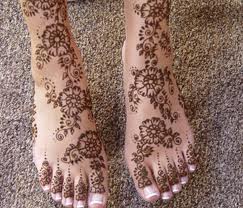Mehndi Designs
Mehndi is the application of henna as a short-term way of epidermis design in Native indian, Pakistan, Nepal and Bangladesh as well as by expatriate areas from those nations. The phrase mehndi is resulting from the Sanskrit term mendhikā.The use of mehndi and turmeric extract is described in the first Hinduism's Vedic habit guides. Hilde (Staining you with turmeric extract paste) as well as mehndi is Vedic traditions, designed to be a representational reflection of the external and the inner sun. Vedic traditions are based on the idea of "awakening the inner light".
Traditional Indian styles are of representations of the sun on the hand, which, in this perspective, is designed to signify the arms and legs.
Mehndi designs became stylish in the European in the delayed 90's, where they are sometimes called henna body art styles. Henna is typically used during special events like marriages and Islamic festivities such as Eid-ul-Fitr and Eid-ul-Adha as well as in Hindu festivities like Karva Chauth, Diwali, Bhaidooj and Teej. In some Hindu festivities, many females have Henna used to their arms and legs. It is usually attracted on the hands and legs, where the design will be best because the epidermis on these areas normally contains less of the color, melanin. Henna was initially used as a way of design mainly for wedding brides.
In the modern age, usually individuals buy readymade Henna cones, which are ready to use and create artwork easy. However, in non-urban areas in Native Indian, females smash fresh henna results in on farming rocks with added oil, which though not as enhanced as expertly prepared henna cones, delivers much deeper shades.
The term henna body art is figurative, because true body art styles are lasting surgery insertions of pigmentation beneath epidermis, in contrast to pigmentation relaxing on the surface as is the case with mehndi.
Likely due to the desire for a "tattoo-black" overall look, many individuals have started including the artificial dye p-Phenylenediamine (PPD) to henna to give it a dark color. PPD is extremely harmful to the epidermis and can cause serious allergies leading to lasting injury or loss of life.Alata (Maher) is a flower-based dye used to color you of the wedding brides in some areas of Native Indian. It is still used in Bengal
Process
Weddings in Pakistan or Native Indian can often be long, ritualistic, and intricate matters with many pre-wedding, wedding and post wedding marriage. The occasion of Mehndi wedding is often one of the most important pre-wedding traditions especially for the bride-to-be. It is a fun loaded habit, which is famous mainly by the bride's family. Different areas of the country enjoy the habit in a different way according to their own wedding traditions, traditions, and lifestyle. Mehndi events take place outside Native Indian and Pakistan amongst the Indian/Pakistani group and places like Manchester in the UK are such known locations for luxurious Mehndi festivities.
The wedding is mainly organized at the bride's house or at a food area on the eve of the big occasion or few days before the wedding. Usually the couple be present at the occasion together and on the occasion a professional henna specialist or a comparative is applicable mehndi to the bride's arms and legs. The styles are very complex. Often invisible within the mehndi routine the name or names of the bridegroom are used. The occasion generally has a celebratory event feel to it with the females bouncing and performing conventional music and the girls dressed in stunning shades such as hot white and yellow-colored, often if the bride-to-be to be desires to mock her future bridegroom she will create him wear violet. The bridegroom usually would wear jutti instead of western shoes.
Best Mehndi Design





No comments:
Post a Comment